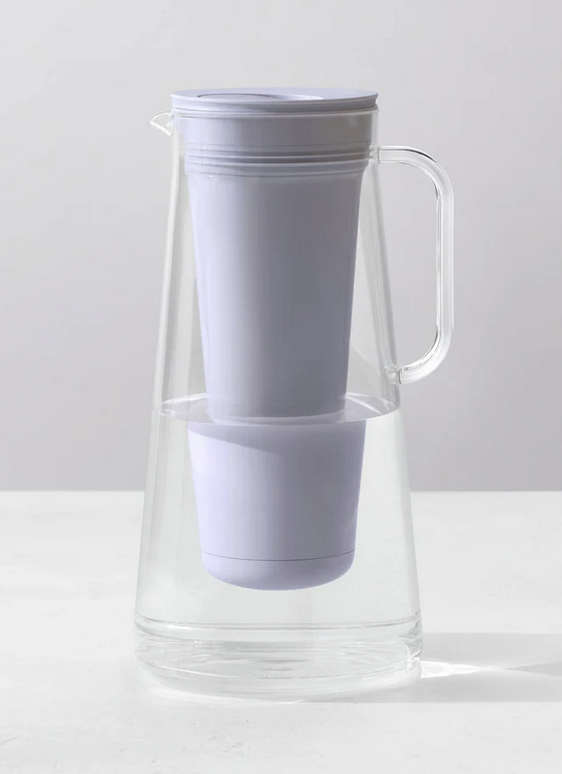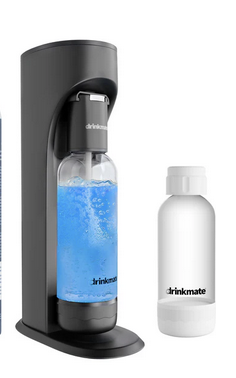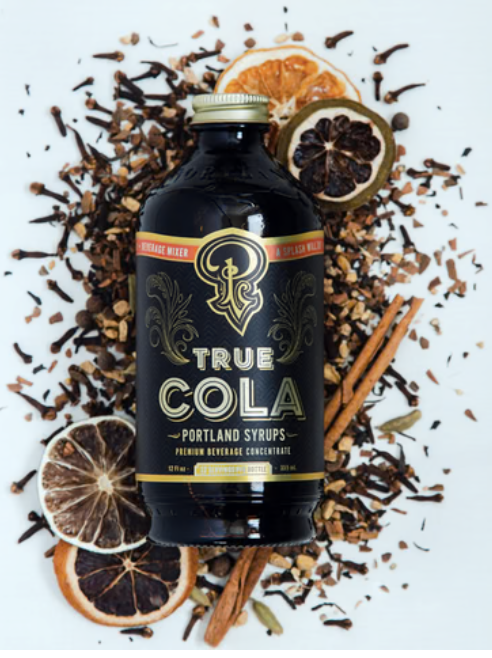Drink Responsively – Use Single-Use Plastic Bottles Less
By Chef David [Updated May 13, 2025]
Consider substituting glass for single-use plastic bottles, it is good for the environment and your health. Plastics were developed at the turn of the century by Belgian chemist Leo Baekeland. In 1947, plastic bottles were first used commercially. However, they were too expensive for consumer products. In the 1950s, high-density polyethylene was introduced, which made plastics the new standard.
Over time, plastic became a consumer staple, while at the same time, the disposal of plastics created environmental concerns. Plastic takes centuries to decompose, and when it does, it breaks down into microplastics. Microplastics are fragments of any type of plastic less than 5 mm in length, they are small enough to cross cell barriers. Microplastics can be found throughout the human body, and researchers are finding associations with health issues. They can be found in all parts of the world, from the Antarctic to the bottom of the oceans, making their way into the food chain.
The full impact of microplastics is unknown, but it is prudent to reduce exposure to microplastics.
Not all plastics are the same. There are some plastics we know to avoid, like BPA, which is used in polycarbonate bottles to make them strong and shiny, and PVC (found in vinyl). But, since manufacturers are not required to disclose how they produce plastics, or if they include additives, we can’t determine the full impact of plastic bottles. Substituting glass containers for single-use plastic containers is one way to reduce your exposure to microplastics and help the environment. There will always be instances where plastic works better, which is fine, and we know that changing habits can be difficult. We recommend starting slowly. Filtration Pitcher Begin with a filtering pitcher, which can sit on your kitchen counter and provide a continuous supply of filtered water. This is a simple substitution. Instead of reaching for a plastic bottle, fill a glass with water. Instead of buying cases of plastic, single-use water bottles, your pitcher provides unlimited water straight from your tap. We were surprised that filtered water tasted different than bottled water. Over time, we grew to appreciate the flavor of pure filtered water. Start a New Routine Drinking filtered water from Lifestraw’s Home Water Pitcher is a three-step process beginning with installing the filters (LifeStraw’s filtration system uses two filters) Before using a filtration pitcher, you need to run the water through it to remove any contaminants and then discard the water. Think of this as a test run. Afterward, fill the pitcher and drink. We recommend keeping the pitcher filled, eliminating any waiting. Lifestraw recommends cleaning the pitcher weekly, using detergent and a sponge (avoid getting soapy water in the filter head). If you are not using it for over 2 weeks, store it dry (you don’t need to remove the filters). If you are storing it for over two months, you will want to replace the filters. Before using the pitcher, run the water through it just like you did with the new product. Why LifeStraw? The LifeStraw water filter comes in both glass and plastic pitchers. They use a double filtration system that removes bacteria and parasites as well as lead, microplastics, and 30+ contaminants while keeping minerals like magnesium and potassium. LifeStraw uses two separate filters. The membrane is an advanced hollow fiber membrane technology; it is like bundles of straws with microscopic holes that filter out bacteria, parasites, and microplastics. The membrane microfilter will stop allowing water through once it’s reached the end of its lifetime of about 264 gallons (approximately one year). The second filter is an activated carbon + ion exchange filter that removes specific chemicals and heavy metals and lasts 40 gallons (2 – 3 months, depending on use). Our Experience Overall, we were satisfied with LifeStraw’s ability to remove impurities from tap water. The biggest surprise was that filtered water had a different flavor, which took some time to adjust to. Drinking water from glasses as opposed to chugging water from single-use plastic bottles was a pleasant adjustment. Using a filtered water pitcher was a well-received adjustment. The amount of time that it took to fill the pitcher was longer than we initially anticipated, but by creating a routine of refilling regularly, we were able to maintain a supply of filtered water on demand. Filtering your tap water adds additional upfront costs but can make drinking water safer. You will need to purchase the water filtration pitcher and filters, but over time, the costs will be comparable. LifeStraw tells us clearly what they have filtered out, while water companies do not. The LifeStraw ‘starter kit’ includes a glass pitcher, silicone base, Membrane Microfilter, and Carbon Filter. We wish they included additional carbon+ ion exchange filters (which are available for purchase separately). Save and Serve with Glass Pitchers LifeStraw’s glass pitcher is designed for producing clear, clean water and comes in 7 or 10 cup sizes. While the pitcher can be used for serving, we often had to wait for the water to filter. For an uninterrupted supply of water, we used glass containers for storage and serving. We selected the Anchor Hocking Bistro, a water pitcher that is strong, stable, and has a wide mouth with a spout. This pitcher is a rectangular shape with an indented grip rather than a handle, designed to fit into the refrigerator without wasting space. The Bistro is stout, with stylized, ridged sides, which make it stable and is designed with an indent that makes it easy to grip. They also make the carafe, which is smaller, lighter, with a wide mouth for easy pouring and serving. One design change we would recommend would be to make the openings wider so they can be cleaned by hand. (But then most people use dishwashers.) A Practical Pair The Anchor Bistro Pitcher and the carafe come with covers. The pitcher cover is made of loose-fitting white polypropylene that does not absorb smells, while the carafe has a tight-fitting plastic lid. The lids should be hand-washed, but the glassware is dishwasher safe. Anchor Hocking – Glass Experts Anchor Hocking has been making high-quality glassware for over 100 years, beginning in 1905 in Lancaster, Ohio. They have an extensive offering of glassware, created by combining their knowledge of glassmaking with their expertise in storage solutions. Anchor Hocking products are sold through a network of retailers. Anchor products are both practical and elegant. The carafe and pitcher are simple classic designs. We liked the way the light refracted through the ridges in the pitcher elevates water, and the clean lines of the carafe for a timeless design. Both are functional and well-made. Using the carafe and pitcher in tandem provided ample storage using the heavier pitcher, while the carafe is ideal for serving at the table. The LifeStraw water pitcher, along with an Anchor, lessens your dependence on single-use plastic water bottles. Further limit your use of single-use plastic seltzer bottles with DrinkMate Onmifizz and create any seltzer flavor you can dream up, served in style using the carafe. Seltzer On Demand – Drinkmate Omnifizz Begin with filtered water and make your own seltzer or carbonate any beverage with Drinkmate Omnifizz. Imagine how great it would be at Passover time, when selections are limited and prices are high, to make your own carbonated beverages. Drinkmate lets you add bubbles to anything. This Drinkmate is easy to use, with minimal assembly. You need to add the carbonator into the housing on the back, then you can begin. The Drinkmate comes with a BPA-free 1-liter reusable carbonating bottle (with a cap) and a Fizz Infuser. Fill the carbonating bottle to the fill line and slide it into the Fizz Infuser, which fits into a slot on top of the unit. Tilt it upwards to screw the bottle in securely, then face the bottle vertically and prepare to carbonate. Press the button on top of the unit and several short bursts until the sound changes. Move the Fizz Infuser upwards, away from the machine, and slide it out of the slot. Then, flip up the tab and let some carbonation escape before opening. That’s it. DrinkMate requires no electricity or batteries and is easy to clean. It comes in a choice of five colors, we tested basic black. We thought that the design was sleek and liked that the unit was stable. Drinkmate, aka I-Drink Products Inc., is based in Ann Arbor, Michigan. The machine can use standard threaded 60L CO2 cylinders from Drinkmate or SodaStream. Our Experience Drinkmate was a great way to reduce our use of single-use plastics, and it was far more convenient than carrying seltzer bottles from the store. The power of the carbonation took some getting used to. Knowing when you have added enough carbonation to stop pumping or let out enough pressure takes experience. Over time, it became easier to know exactly how much CO2 to add. We found that we could get exactly the right amount of fizz. With Drinkmate, you can carbonate any beverage. We enjoyed creating unique soda flavors with Portland Syrups, certified by Oregon Kosher. These syrups are rich, bold, concentrated flavors that are exciting combinations when added to seltzer, transforming it into an explosion of flavor, and let you move away from store-bought sodas entirely. We experimented with True Cola. They have classics like Root Beer, Vanilla, and Ginger, along with less conventional syrups, including Meyer Lemon Syrup, Raspberry Rhubarb, Grenadine, Margarita, and Lavender. With over 20 flavors, they offer something for every taste. We recommend adding the flavors directly to your cup. Their syrups contain real ingredients, True Cola has water, cane sugar, kola nut, whole spices, organic concentrate of lime and orange, and natural vanilla. One ounce has 50 calories. This is what cola should taste like! The best part is that you can adjust the sweetness by adding syrup. Portland Syrups is a small batch artistical manufacturer since 2012. Their products reflect their dedication to quality and attention to detail. They begin their process by carefully selecting ingredients sweetened with pure cane sugar and packed in glass bottles. Dan McLaughlin, Founder and CEO of Portland Syrups, noted, “We saw a gap in the market for premium grenadines, as all of the store-bought options are overly sweet and made with artificial sweeteners.” We are grateful they did. Porland Syrups come in distinctive glass bottles. Portland Syrups is available for purchase online. Building on The Basics Moving away from single-use plastic bottles is good for the environment and your health. Even though we do not yet know the full effect of microplastics, we do know how much lighter your shopping trips will become without the need to purchase bottled water, seltzer, and sodas. We began with the basics, water, and then found that starting with fresh, pure water is just the beginning. We recommend starting simple with the LifeStraw water filter pitcher, and if you like carbonated beverages add the Drinkmate Omnifizz. With Portland Syrups, anyone can be a mixologist and make soda the traditional way.

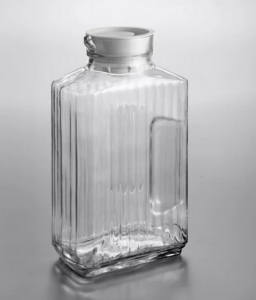
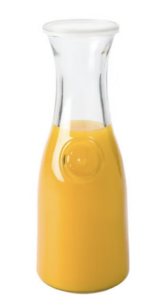
Related Posts
Tags
Share This

